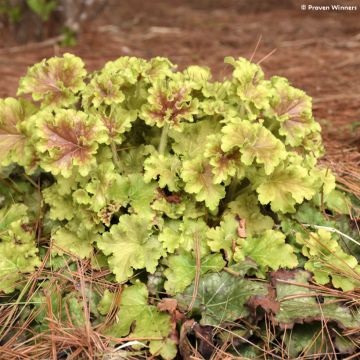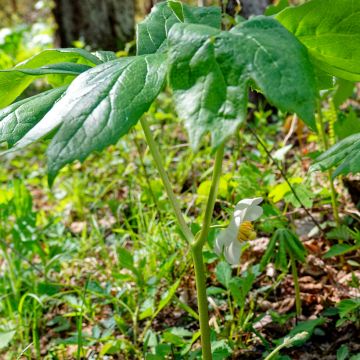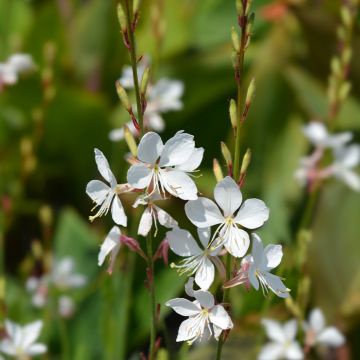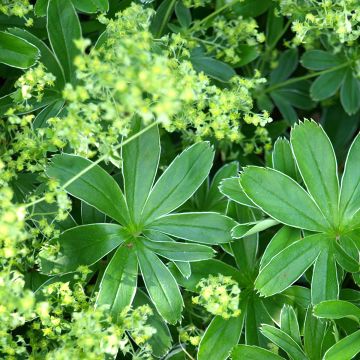

Heuchera Bloody Dinosaur - Heuchère
Heuchera Bloody Dinosaur
Heuchera Bloody Dinosaur
Coral Bells, Alumroot
Lovely variety, I am happy.
Stephen, 29/11/2024
This item cannot be shipped to the selected country
Delivery charge from €5.90
More information
Schedule delivery date,
and select date in basket
This plant carries a 12 months recovery warranty
More information
We guarantee the quality of our plants for a full growing cycle, and will replace at our expense any plant that fails to recover under normal climatic and planting conditions.
From €5.90 for pickup delivery and €6.90 for home delivery
Express home delivery from €8.90.

Does this plant fit my garden?
Set up your Plantfit profile →
Description
The Heuchera 'Bloody Dinosaur' is an excellent variety of heuchera, both colourful and vigorous, that will quickly make an impact in the garden, as well as in a pot. It forms a ground-covering clump, evergreen in winter, composed of large leaves displaying various shades of red, more or less amber, coppery, going all the way to blood red. In summer, graceful floral stems adorned with white bells further enhance its appeal. This perennial plant truly transforms any setting. It simply requires a morning sun exposure, partial shade, or can even survive full shade.
In recent years, heucheras have become essential plants in our gardens. Their evergreen foliage, available in multiple shades, brightens up flower beds brilliantly. These plants from the Saxifragaceae family make fantastic borders for flower beds. They also yield excellent results in pots, allowing them to adorn even a modest terrace. The Heucheras from the 'Dinosaur' series were selected by Dirk Scheys for their very rapid growth and large leaves that make a good ground cover in the garden. These varieties also serve as a focal point on terraces and balconies.
The 'Bloody Dinosaur' heuchera reaches a height of approximately 35 cm (14in) and a width of 60 cm (24in) when fully grown. Its delicate inflorescences, which appear in July, rise above the lobed foliage. This foliage, whose colour evolves with the passing days and seasons, is a constant delight. In 'Bloody Dinosaur', the leaves are large and deeply veined. Their colour ranges from reddish-brown to blood red. In autumn, this foliage becomes significantly darker, with a reddish-bronze colour, and the undersides display a purplish hue that catches the eye.
The 'Bloody Dinosaur' heuchera, like many other heucheras, is truly undemanding when it comes to soil, as long as it is well-drained and not too dry in summer. It prefers partial shade or shade, but still needs some light, at least in the morning, to express its beautiful colours. However, it will scorch if exposed to full sun. Plant several specimens of this heuchera to achieve a spectacular and perfectly ground-covering effect. You can also combine it with other varieties in matching colours such as the famous 'Caramel' or 'Caribbean Sea'. On the other hand, you can create contrasts with dark heucheras like 'Black Beauty'. In the shade, its bright foliage will enhance the dark foliage of ferns (Dryopteris, Polystichum), Liriopes, or Ophiopogons. Finally, it can create a beautiful colour motif with shrubs such as Berberis 'Admiration'.
Report an error about the product description
Flowering
Foliage
Plant habit
Botanical data
Heuchera
Bloody Dinosaur
Saxifragaceae
Coral Bells, Alumroot
Cultivar or hybrid
Other Heuchera
Planting and care
Prepare a planting hole for your 'Bloody Dinosaur' heuchera measuring 20 cm (8in) x 20 cm (8in) x 20 cm (8in). If your soil is heavy, mix some compost with the crumbled soil, partially backfill the hole, and place your seedling (after removing the pot) in such a way that the top of the plant's root ball is covered with 3 cm (1in) of soil. The addition of a basal fertiliser (dehydrated blood, horn powder) will nourish your plant during its rooting period without the risk of burning. Firmly tamp down the soil and water generously to eliminate any air pockets.
If the weather is dry, you will need to water regularly for a few weeks to facilitate the establishment of your plant. Also, avoid excessive drying of the soil in summer, even though well-rooted plants are not very water-demanding. Heucheras renew their foliage at the end of winter, so we recommend pruning the previous year's leaves in January or February.
Planting period
Intended location
Care
-
, onOrder confirmed
Reply from on Promesse de fleurs
Summer flowering perennials
Haven't found what you were looking for?
Hardiness is the lowest winter temperature a plant can endure without suffering serious damage or even dying. However, hardiness is affected by location (a sheltered area, such as a patio), protection (winter cover) and soil type (hardiness is improved by well-drained soil).

Photo Sharing Terms & Conditions
In order to encourage gardeners to interact and share their experiences, Promesse de fleurs offers various media enabling content to be uploaded onto its Site - in particular via the ‘Photo sharing’ module.
The User agrees to refrain from:
- Posting any content that is illegal, prejudicial, insulting, racist, inciteful to hatred, revisionist, contrary to public decency, that infringes on privacy or on the privacy rights of third parties, in particular the publicity rights of persons and goods, intellectual property rights, or the right to privacy.
- Submitting content on behalf of a third party;
- Impersonate the identity of a third party and/or publish any personal information about a third party;
In general, the User undertakes to refrain from any unethical behaviour.
All Content (in particular text, comments, files, images, photos, videos, creative works, etc.), which may be subject to property or intellectual property rights, image or other private rights, shall remain the property of the User, subject to the limited rights granted by the terms of the licence granted by Promesse de fleurs as stated below. Users are at liberty to publish or not to publish such Content on the Site, notably via the ‘Photo Sharing’ facility, and accept that this Content shall be made public and freely accessible, notably on the Internet.
Users further acknowledge, undertake to have ,and guarantee that they hold all necessary rights and permissions to publish such material on the Site, in particular with regard to the legislation in force pertaining to any privacy, property, intellectual property, image, or contractual rights, or rights of any other nature. By publishing such Content on the Site, Users acknowledge accepting full liability as publishers of the Content within the meaning of the law, and grant Promesse de fleurs, free of charge, an inclusive, worldwide licence for the said Content for the entire duration of its publication, including all reproduction, representation, up/downloading, displaying, performing, transmission, and storage rights.
Users also grant permission for their name to be linked to the Content and accept that this link may not always be made available.
By engaging in posting material, Users consent to their Content becoming automatically accessible on the Internet, in particular on other sites and/or blogs and/or web pages of the Promesse de fleurs site, including in particular social pages and the Promesse de fleurs catalogue.
Users may secure the removal of entrusted content free of charge by issuing a simple request via our contact form.
The flowering period indicated on our website applies to countries and regions located in USDA zone 8 (France, the United Kingdom, Ireland, the Netherlands, etc.)
It will vary according to where you live:
- In zones 9 to 10 (Italy, Spain, Greece, etc.), flowering will occur about 2 to 4 weeks earlier.
- In zones 6 to 7 (Germany, Poland, Slovenia, and lower mountainous regions), flowering will be delayed by 2 to 3 weeks.
- In zone 5 (Central Europe, Scandinavia), blooming will be delayed by 3 to 5 weeks.
In temperate climates, pruning of spring-flowering shrubs (forsythia, spireas, etc.) should be done just after flowering.
Pruning of summer-flowering shrubs (Indian Lilac, Perovskia, etc.) can be done in winter or spring.
In cold regions as well as with frost-sensitive plants, avoid pruning too early when severe frosts may still occur.
The planting period indicated on our website applies to countries and regions located in USDA zone 8 (France, United Kingdom, Ireland, Netherlands).
It will vary according to where you live:
- In Mediterranean zones (Marseille, Madrid, Milan, etc.), autumn and winter are the best planting periods.
- In continental zones (Strasbourg, Munich, Vienna, etc.), delay planting by 2 to 3 weeks in spring and bring it forward by 2 to 4 weeks in autumn.
- In mountainous regions (the Alps, Pyrenees, Carpathians, etc.), it is best to plant in late spring (May-June) or late summer (August-September).
The harvesting period indicated on our website applies to countries and regions in USDA zone 8 (France, England, Ireland, the Netherlands).
In colder areas (Scandinavia, Poland, Austria...) fruit and vegetable harvests are likely to be delayed by 3-4 weeks.
In warmer areas (Italy, Spain, Greece, etc.), harvesting will probably take place earlier, depending on weather conditions.
The sowing periods indicated on our website apply to countries and regions within USDA Zone 8 (France, UK, Ireland, Netherlands).
In colder areas (Scandinavia, Poland, Austria...), delay any outdoor sowing by 3-4 weeks, or sow under glass.
In warmer climes (Italy, Spain, Greece, etc.), bring outdoor sowing forward by a few weeks.























































